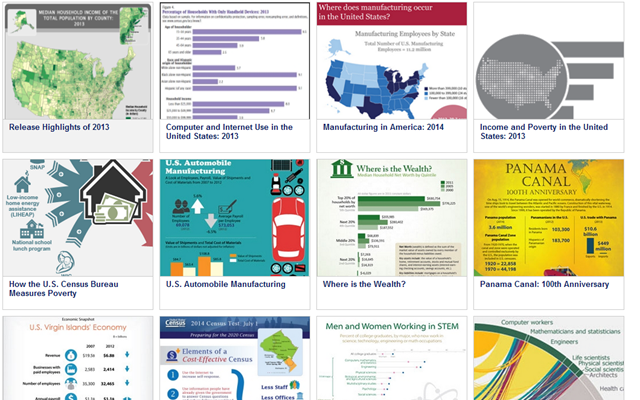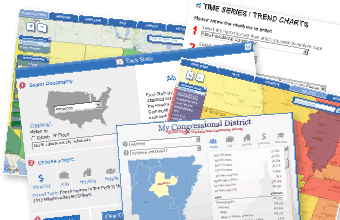Tip Sheet Number 4 — February 21, 2025
Upcoming
2025 Product Calendar
The U.S. Census Bureau has posted anticipated release dates for each regular and recurring statistical product scheduled for release in 2025. These products are listed in the Census Bureau’s online product calendar, which is updated as needed throughout the year.
2020 Modified Age and Race Census (MARC) File
The U.S. Census Bureau is scheduled to release national and county-level modified age and race data by single year of age, sex, race and Hispanic origin from the 2020 Census. Files were created by applying smoothing to a subset of age data as well as redistributing the “Some Other Race” values from the 2020 Census into the five race categories included in the U.S. Office of Management and Budget 1997 revised standards for the collection, tabulation and presentation of federal data on race and ethnicity. These data will allow for accurate comparisons by race between 2020 Census results, the 2020 Demographic Analysis estimates and the official population estimates. The MARC file is one of several 2020 Census demographic data releases. Visit the Modified Race Data webpage to access modified race data from the 2010 and 2000 Censuses. (Scheduled for release March 6.)
American Community Survey
Census Bureau to Release Report Examining Geographic Mobility in the United States by Birth Cohorts or Generations
Geographic mobility refers to the movement of people within and across geographic boundaries. Birth cohorts are groups of people who were born in the same timeframe and pass through life together. This report is based on 2005-2023 American Community Survey 1-year estimates. (Scheduled for release in March.)
Demographic
Census Bureau Releases Vintage 2024 Estimates of Population and Demographic Components of Change for Metropolitan and Micropolitan Statistical Areas and Counties, and Estimates of Population for Puerto Rico Municipios
Internet tables and detailed downloadable files will show annual population estimates, rankings and components of population change for metropolitan and micropolitan statistical areas and counties, as well as population estimates for Puerto Rico municipios, since the 2020 Census. (Scheduled for embargo March 11; public release March 13.)
Household Pulse Survey
The experimental Household Pulse Survey (HPS) is an effort by the Census Bureau and other federal statistical agencies to measure how emergent issues are impacting U.S. households from a social and economic perspective.
The Census Bureau has changed the HPS to enhance efficiency and representativeness of the data. Since early October 2024, HPS content has been incorporated into a longitudinal design, with data collection occurring bi-monthly. The longitudinal design will benefit HPS data by allowing direct measurement of change over a longer period in critical elements like spending, inflation, and other social and economic indicators of well-being. The October public-use file was released Dec. 18, 2024; the December 2024 public-use file will be released in February, 2025. With the change to a longitudinal design, the sample size is smaller and data will be released at a national level.
To acknowledge these design changes, the Census Bureau rebranded the HPS as the Household Trends and Outlook Pulse Survey (HTOPS) in January 2025.
Economic
“Are Jobs Leaving Your State?”
The U.S. Census Bureau and the Local Employment Dynamics (LED) Partnership in collaboration with the Council for Community and Economic Research (C2ER) and the Labor Market Information (LMI) Institute, welcomes Nicol Nicola as she presents, “Are Jobs Leaving Your State?” This pressing question has captured the attention of politicians, the media, residents and scholars alike. This session will offer a data-driven analysis of job movement in New Jersey using the Longitudinal Employer-Household Dynamics (LEHD) data, specifically leveraging Job-to-Job Flows metrics. It will examine where job shifts are occurring—both geographically—breaking down key indicators such as origin, destination, and net change. Finally, it will contextualize these movements by comparing them to the total workforce size, providing a clearer picture of New Jersey’s employment dynamics. (Scheduled for March 19.)
Business Trends and Outlook Survey (BTOS)
The BTOS measures business conditions on an ongoing basis. The BTOS experimental data products are representative of all employer businesses in the U.S. economy, excluding farms. The data allow greater insight into the state of the economy by providing continuous, timely information for key economic measures. Data are released biweekly and are available by sector, state, employment size and the 25 most populous metropolitan statistical areas.
Monthly Business Formation Statistics
Business Formation Statistics (BFS) provide timely, high-frequency data on business applications and employer business formations monthly. The data are available at the state, regional and national levels, and by industry sector at the national level. The next monthly BFS will be released March 12 and will include February 2025 data. Business Formation Statistics - Release Schedule (census.gov).
Recently Released
(Released since Feb. 7, 2025)
Economic
OnTheMap for Emergency Management Data Update — Feb. 18
The U.S. Census Bureau recently released version 4.24.3 of OnTheMap for Emergency Management. OnTheMap for Emergency Management provides real-time access to a range of detailed Census Bureau data about the people living and working in areas affected by hurricanes, floods, wildfires, winter storms and federal disaster declaration areas. The latest version of the tool includes updates incorporating 2019-2023 American Community Survey (ACS) 5-year estimates and 2022 Longitudinal Employer-Household Dynamics Origin-Destination Employment Statistics (LODES) data.
2024 Annual Business Survey First Look — Feb. 13
The U.S. Census Bureau released new first look data from the 2024 Annual Business Survey (ABS) covering reference year 2023. Data included estimates on employer business credit use and domestic manufacturing activities by owner characteristics. The ABS is conducted jointly by the Census Bureau and the National Center for Science and Engineering Statistics (NCSES).
Gridded Environmental Impacts Frame (Gridded EIF) — Feb. 11
The U.S. Census Bureau recently released the Gridded Environmental Impacts Frame (Gridded EIF), a new experimental data product that integrates detailed administrative record and survey data on the U.S. population with high-resolution geospatial information on environmental hazards. Gridded EIF provides detailed demographic counts by age, sex, race and ethnicity; counts of the population by race and ethnicity and household income decile; and exposure data for several key environmental hazards including air pollution. Gridded EIF enables researchers to conduct advanced spatial analyses while upholding strict confidentiality standards.
Facts for Features
National Black History Month: February 2025 — Dec. 11
To commemorate and celebrate the contributions to our nation made by people of African descent, the U.S. Census Bureau presents a collection of demographic and economic statistics about the Black community.
America Counts: Stories Behind the Numbers
America Counts tells the stories behind the numbers in a new and inviting way. We feature stories on various topics such as families, housing, employment, business, education, the economy, emergency preparedness and the population. New stories include:
Stats for Stories
Stats for Stories provides links to timely story ideas highlighting the Census Bureau’s newsworthy statistics that relate to current events, observances, holidays and anniversaries. The story ideas are intended to assist the media in story mining and producing content for their respective audiences.
Resources
Emergency Management/Disaster Resources
When major disasters strike, visit our Emergency Management webpage for demographic and economic data on impacted areas. Each disaster will include data from our key emergency management tools: OnTheMap for Emergency Management, Community Resilience Estimates, Census Business Builder: Regional Analyst Edition, and other useful resources.
Learn What Surveys Are Being Conducted in Your Community
Discover which of the U.S. Census Bureau’s 130-plus annual surveys are being conducted in your community. In a variety of surveys and censuses, evolving from the first census in 1790, the Census Bureau provides official information about America’s people, businesses, industries and institutions. Learn more about surveys currently being conducted in each Census Bureau region:
Data Tools
Below are a few of the U.S. Census Bureau’s interactive applications used to access statistics from our 130-plus annual surveys. A complete list can be accessed on the Census Bureau’s Data Tools and Apps webpage.
FRED® Economic Data
The U.S Census Bureau’s publicly available data sets and tools to assist in the equitable distribution of resources, and identifying underserved communities.
Job-to-Job Flows Explorer
Analyze the Job-to-Job Flows (J2J) data through interactive charts, maps and tables.
PSEO Explorer
Visualize the experimental Post-Secondary Employment Outcomes (PSEO) data through interactive bar charts and Sankey diagrams.
Training Opportunities
Census Bureau Training Opportunities
Webinars are available on a regular basis to help the public access and use Census Bureau statistics. These free sessions, which are 60 to 90 minutes each, show users how to navigate Census Bureau databases and mapping tools and find demographic and economic statistics at the local or national level. Descriptions of upcoming sessions are available on our Census Academy webpage. Login details are provided at least one week before a webinar.
- New Interactive Charts on data.census.gov (Wednesday, Feb. 25, 2-3 p.m. ET)
- Discovering the American Community Survey 1-Year Supplemental Estimates (Wednesday, Feb. 26, 2-3 p.m. ET)
- Are Jobs Leaving Your State? (Wednesday, March 19, 1:30-2:45 p.m. ET)
- Understanding American Community Survey Tables and Profiles (Wednesday, March 26, 2-3 p.m. ET)
Archived Training Resources — Visit the Census Bureau’s Educational Resource Library for previously recorded, free training available at your convenience. The library includes presentations, recorded webinars, tutorials and other helpful materials.







